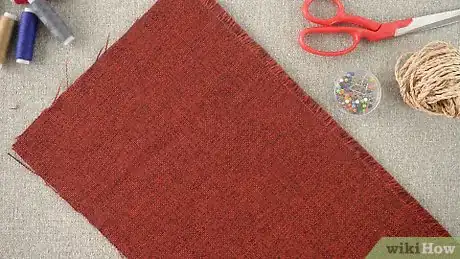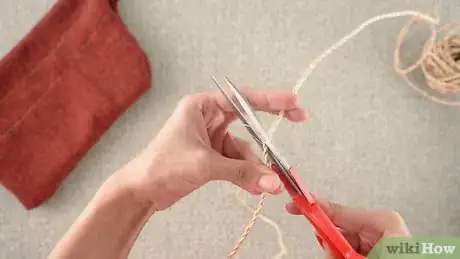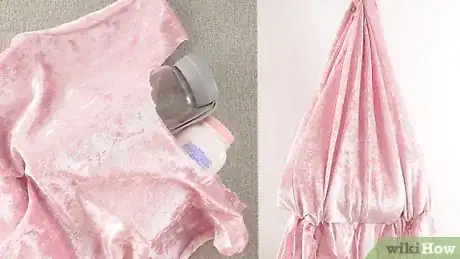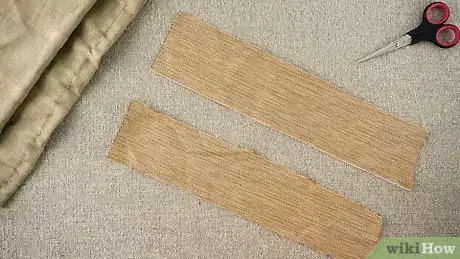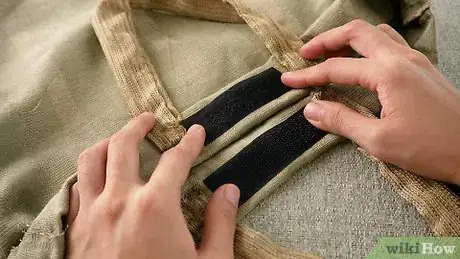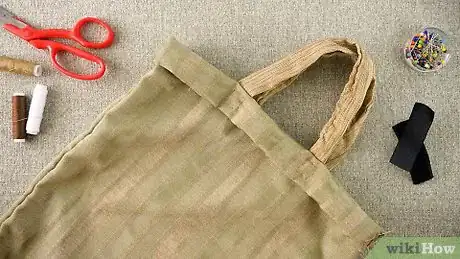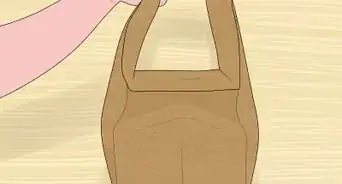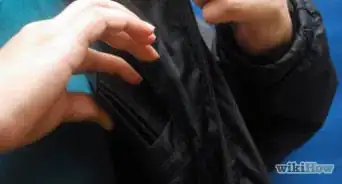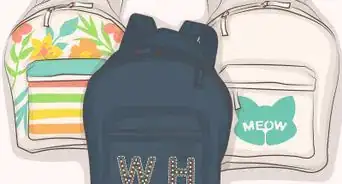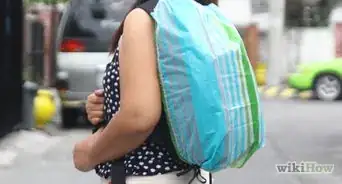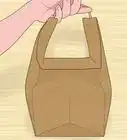This article was co-authored by Mia Danilowicz. Mia Danilowicz is a Master Tailor who works onset and on the red carpet in Los Angeles, California. With over a decade of experience, Mia specializes in bridal and gown couturier fittings, garment reconstruction, and custom design. Mia has worked at the Oscars, Grammys, SAG Awards, and Golden Globes. Her clients include a long list of entertainment and fashion industry headliners, major fashion magazines, luxury consumer brands, and popular media. Mia was trained at the Fashion Institute of Design and Merchandising and received her AA in Fashion Design and BS in Business Management.
This article has been viewed 327,286 times.
Whether it is to present a gift or store your items, making your own bag is a great way to save money and recycle. A t-shirt bag is 1 of the easiest that you can make, because it does not involve any sewing. If you want to get more crafty, however, you can try a simple draw-string pouch or a handled tote bag!
Steps
Sewing a Drawstring Bag
-
1Cut a 10 by 20 in (25 by 51 cm) rectangle out of fabric. Choose a durable fabric, such as cotton, linen, canvas, or jersey. Use a tailor's chalk or pen and a ruler to draw a 10 by 20 in (25 by 51 cm) rectangle on the back of the fabric. Cut the fabric out with fabric scissors.
- The fabric can be solid colored or it can have a print on it.
- This pattern already includes seam allowances, so you don't need to add more.
- You can make a bigger/smaller bag if you want to, but keep the proportions the same. Make it twice as long as it is wide.
- You can also cut 2 matching squares of fabric if you'd like—like if you want the front and back of the bag to be different colors.[1]
-
2Fold 1 of the long edges down by 4 inches (10 cm) and iron it. Turn your fabric so that the back (wrong side) is facing you. Fold 1 of the 20 in (51 cm) edges down by 4 inches (10 cm). Secure it with sewing pins, then press it flat with an iron. This will make the top of your bag.
- Use a heat setting on your iron that is safe for your fabric. For example, if you are making a linen bag, use the linen setting on your iron.
Advertisement -
3Sew 2 lines across the folded edge to create a drawstring channel. The first line needs to be 2 1⁄2 inches (6.4 cm) down from the top of the folded. The second line needs to be 3 1⁄2 inches (8.9 cm) from the fold. When you are done, you will have a 1 inch (2.5 cm) space between the 2 lines; this space will make the channel for the ribbon to go through.
- You can match the thread color to the fabric, or you can use a contrasting color. For example, if you are making a white bag, try red thread for a simple design.
- Use a straight stitch for this. If you are working with stretchy fabric, use a zigzag stitch instead.
- Be sure to backstitch so that the stitching doesn't come undone. This is where you reverse the sewing machine for 2 to 3 stitches.
- Be sure not to sew the sides or you won't be able to insert the drawstring.[2]
-
4Fold your fabric in half, widthwise, with the wrong side facing out. Turn your fabric so that the front (right side) is facing you. Bring the narrow edges together to fold the fabric in half. Insert sewing pins along the bottom and side edge of the rectangle.
- Do not insert any sewing pins along the top or side folded edges.
- It does not matter how many sewing pins you use, or how close together they are. As long as they hold the fabric in place, you are good.
-
5Sew along the bag together using a 1⁄2 in (1.3 cm) seam allowance. When sewing the side, skip the 1 in (2.5 cm) gap between the 2 horizontal lines you sewed earlier, or you won't be able to insert the drawstring. When you are done, remove the sewing pins.
- Use a straight stitch for woven fabric, and a zigzag stitch for stretchy fabric.
- Remember to backstitch when you start and finish sewing.
- You are only sewing where the pins are. Do not sew across the top or side folded edges.
-
6Turn the bag right-side-out. For a nicer finish, cut the bottom corners off as close to the stitching as possible, before you turn the bag right-side-out.[3] You can also finish the seams with a serger or a zigzag stitch, but this is not absolutely necessary.
- Some fabric frays more than others. If the fabric is fraying, then you should finish the seams with a serger or a zigzag stitch.
-
7Cut a 20 in (51 cm) long piece of ribbon or string. Choose a piece of ribbon or string that is no more than 1⁄2 inch (1.3 cm) wide.[4] Measure out 20 inches (51 cm), then cut it. This will make the drawstring that will open and close your bag.
- Match the color to your bag, or use a contrasting color. For example, if you have a blue canvas bag, a thin, white rope would look nice.
- If your ribbon or string is made from polyester, singe the cut ends with a flame to prevent unraveling.
- If your ribbon or string is not made from polyester, seal the cut ends with fabric glue or fray-check. Let the ends dry before moving on.
-
8Use a safety pin to insert the drawstring. Pin the safety pin to the end of your drawstring. Find the 1 in (2.5 cm) wide gap on the inside of your bag, then insert the safety pin. Guide the safety pin through the channel until you reach the gap again. Remove the safety pin when you are done.
-
9Close the bag by scrunching it along the drawstring. Once you have the bag closed, ie the ends of the drawstring into a bow. If you'd like, you can place a pretty bead onto each end of the ribbon; tie each end into a knot to hold the bead on.
Tying a No-Sew T-shirt Bag
-
1Choose a t-shirt you won't mind cutting up, and turn it inside-out. The size of the t-shirt does not matter. You can use a small shirt for a small bag, or a large shirt for a larger bag. It would be best if you use a regular t-shirt rather than a fitted one, however.[5]
- The shirt can be old, but make sure that it is clean and without any holes or stains.
Consider using a shirt with an interesting print or graphic on the front. This will be visible on the outside of the bag once you are done.If the shirt is white, consider tie dyeing it. If it is black, you could do a reverse tie dye with bleach!
-
2Cut the sleeves off using the seams as a guide. If you want longer handles, fold the shirt in half first, then extend your cut below the armpits. By folding the shirt in half, you can ensure that both long handles will come out symmetrical.
- Try to use a good pair of fabric scissors for this. Regular scissors will still work, but they don't give you as clean of a cut.
-
3Cut the collar off. How much you cut off of the neck is up to you, but make sure that you cut the same amount off of the back as you did off of the front. Also, try to leave 2 to 3 inches (5.1 to 7.6 cm) of space between the neckline and the sleeves. This will make your handles more durable.
- To make your neckline more even, trace the curve using a marker and a bowl or plate first.
-
4Decide on the length of your bag, then draw a line across the shirt. How long you make your bag is up to you, but remember that your bag will stretch a little when you put things inside it. If you want your bag to be the same length as your shirt, simply make the line about 1 to 2 inches (2.5 to 5.1 cm) above the hem.[6]
- Use a ruler or some other straight edge to make the line as even as possible.
- You need this horizontal line because you will be cutting a fringe into the bottom edge of your shirt.
-
5Cut 3⁄4 to 1 in (1.9 to 2.5 cm) wide slits into the hem, stopping at the line. Make these slits about 3⁄4 to 1 inch (1.9 to 2.5 cm) wide. Start on the left side of the shirt and finish on the right. Be sure to cut through both layers of the shirt as well as the side seams. When you are done, you'll end up with a shirt that has a tasseled bottom.[7]
- If you need to, draw guidelines for the slits before you begin cutting.
-
6Turn the shirt right-side-out, then tie the tassels together. Turn your shirt right-side-out first. Take the first tassel on the front of the shirt and tie it to the first tassel on the back of the shirt into a single knot. Repeat this step for all of the tassels until you reach the other side of your shirt.[8]
- Don't worry if the single knot doesn't seem very secure. The next step will resolve that.
- The knots and tassels will be part of your bag's final design. If you don't want them to be visible, then don't turn your shirt right-side-out.
-
7Tie the adjacent tassels together to hide the gaps. Your bag will likely have tiny gaps between the knots. You will need to hide them, or your bag won't be able to hold small items. To do this, you will need to tie the first and second tassels together, the third and forth tassels together, and so forth.[9]
- Do this for both sides of the bag. Start with the front, then do the back.
-
8Trim the tassels, if desired. Depending how how short you make the bag, the tassels can be either very long or very short. If you want your tassels to be shorter, trim them down to your desired length. Don't go shorter than 1 inch (2.5 cm), however!
- If you are keeping the tassels on the inside of your bag, you should trim them down as well so that they don't get tangled.
- If you want to keep the tassels long, consider adding some pony beads onto them. Tie knots under the beads, if needed, to keep them in place.
Making a Tote Bag
-
1Cut a piece of fabric twice the height you want your bag to be. The fabric needs to be the same width as your desired bag, plus 1 inch (2.5 cm) for the side seam allowances. You should also add 1 inch (2.5 cm) to the overall height for the hems.
- For example, if you want a 6 by 12 in (15 by 30 cm) bag, your fabric should be 7 by 25 inches (18 by 64 cm).
- Use a sturdy fabric, such as canvas, cotton, linen or canvas.
-
2Fold the narrow edges down by 1⁄2 inch (1.3 cm) to make the hems. Turn your fabric so that the back (wrong) side is facing you. Fold the narrow edges down by 1⁄2 inch (1.3 cm), then insert sewing pins to keep them down. Press them with an iron to make them nice and crisp.
- Use the right heat setting on your iron for the fabric that you are using.
-
3Sew the hems as close to the raw edge as you can. A seam allowance that is between 1⁄8 and 1⁄4 inch (0.32 and 0.64 cm) should be fine. Use a straight stitch for woven fabrics, and a zigzag stitch for stretchy fabrics. Be sure to backstitch when you start and finish sewing, and to remove the pins when you are done.
- If you don't know how to sew, you can use iron-on hem tape or fabric glue.
- Match the thread color to the fabric, or use a contrasting color for a more interesting effect.
-
4Fold the fabric in half, with the right sides facing in. Turn the fabric so that the front (right) side is facing you. Bring both of the hemmed edges together, then secure the raw edges with sewing pins. Leave the top, hemmed edges alone.
-
5Sew the side hems using a 1⁄2 in (1.3 cm) seam allowance. Use a straight stitch for woven fabrics, and a zigzag stitch for stretchy fabrics. Backstitch when you start and finish sewing, and remember to remove the pins as you sew.
- If you don't know how to sew, you can use iron-on hem tape or fabric glue.
- For a nicer finish, go over the side seams with a serger or a zigzag stitch.
- Trim off the bottom corners as close to the stitching as you can to reduce bulk.
-
6Cut a long strip of fabric for the handle or shoulder strap. The strip can be whatever length you want it to be, but it needs to be twice the width, plus a 1 in (2.5 cm) seam allowance. You can cut 1 long strip to make a shoulder strap, or 2 short strips to make handles.
- The strap or handle does not have to match your bag. You can use a contrasting color to make your bag look more interesting.
- Use sturdy, woven fabric for this, like cotton, linen, or canvas. Don't use stretchy fabric.
-
7Fold the strip in half, then sew it with a 1⁄2 in (1.3 cm) seam allowance. Fold the strip in half lengthwise with the right sides facing in. Secure the long edge with sewing pins, then sew along it using a 1⁄2 in (1.3 cm) seam allowance and a straight stitch. Remove the pins as you sew and remember to backstitch.
-
8Turn the strip inside-out, the press it with an iron. Clip a safety pin to 1 of the narrow ends, put it through the length of the strip, and out the other narrow end. Remove the safety pin, then press the strip with an iron.
- For a nicer finish, tuck the raw edges into the narrow ends of your strip by 1⁄2 inch (1.3 cm), then sew over them using a 1⁄8 to 1⁄4 in (0.32 to 0.64 cm) seam allowance.
-
9Turn your bag right-side-out and attach the handles. If you made a shoulder strap, attach each end to the top of each side seam. If you made handles, attach your first handle to the front of the bag, and the second handle to the back.
- You attach the handles by sewing or with fabric glue. For a nicer finish, attach them to the inside of the bag.
- If you attached the handles to the outside of the bag, consider adding a pretty button, flower, or other embellishment to the bottom of each strap or handle to hide the joint.
-
10Add a Velcro closure, if you want the bag to open and close. Cut a 1 by 1 in (2.5 by 2.5 cm) piece of Velcro. Find the center of the front and back top hem. Glue each piece of Velcro to the inside of your bag, right against the top edge of the hem. Wait until the glue dries, then press the Velcro together to close the bag.
- Avoid using self-adhesive Velcro. The glue will eventually come off.
- For best results, use fabric glue. You can use hot glue in a pinch, however.
-
11Finished!
Expert Q&A
Did you know you can get expert answers for this article?
Unlock expert answers by supporting wikiHow
-
QuestionHow much string do I need for a drawstring bag?
 Mia DanilowiczMia Danilowicz is a Master Tailor who works onset and on the red carpet in Los Angeles, California. With over a decade of experience, Mia specializes in bridal and gown couturier fittings, garment reconstruction, and custom design. Mia has worked at the Oscars, Grammys, SAG Awards, and Golden Globes. Her clients include a long list of entertainment and fashion industry headliners, major fashion magazines, luxury consumer brands, and popular media. Mia was trained at the Fashion Institute of Design and Merchandising and received her AA in Fashion Design and BS in Business Management.
Mia DanilowiczMia Danilowicz is a Master Tailor who works onset and on the red carpet in Los Angeles, California. With over a decade of experience, Mia specializes in bridal and gown couturier fittings, garment reconstruction, and custom design. Mia has worked at the Oscars, Grammys, SAG Awards, and Golden Globes. Her clients include a long list of entertainment and fashion industry headliners, major fashion magazines, luxury consumer brands, and popular media. Mia was trained at the Fashion Institute of Design and Merchandising and received her AA in Fashion Design and BS in Business Management.
Master Tailor
-
QuestionHow do you make a drawstring pouch?
 Mia DanilowiczMia Danilowicz is a Master Tailor who works onset and on the red carpet in Los Angeles, California. With over a decade of experience, Mia specializes in bridal and gown couturier fittings, garment reconstruction, and custom design. Mia has worked at the Oscars, Grammys, SAG Awards, and Golden Globes. Her clients include a long list of entertainment and fashion industry headliners, major fashion magazines, luxury consumer brands, and popular media. Mia was trained at the Fashion Institute of Design and Merchandising and received her AA in Fashion Design and BS in Business Management.
Mia DanilowiczMia Danilowicz is a Master Tailor who works onset and on the red carpet in Los Angeles, California. With over a decade of experience, Mia specializes in bridal and gown couturier fittings, garment reconstruction, and custom design. Mia has worked at the Oscars, Grammys, SAG Awards, and Golden Globes. Her clients include a long list of entertainment and fashion industry headliners, major fashion magazines, luxury consumer brands, and popular media. Mia was trained at the Fashion Institute of Design and Merchandising and received her AA in Fashion Design and BS in Business Management.
Master Tailor Cut out 2 matching squares that are any size. Sew the sides together, inside-out, starting 1" down from the top. Then, sew the bottom. Press the seams open and clip the bottom corners. At the top, fold it down and stitch 1/2" around to create a drawstring casing, but leave the sides open. Use a safety pin to pull your string or ribbon drawstring through, then flip the bag inside out.
Cut out 2 matching squares that are any size. Sew the sides together, inside-out, starting 1" down from the top. Then, sew the bottom. Press the seams open and clip the bottom corners. At the top, fold it down and stitch 1/2" around to create a drawstring casing, but leave the sides open. Use a safety pin to pull your string or ribbon drawstring through, then flip the bag inside out. -
QuestionHow do you attach a tote handle?
 Mia DanilowiczMia Danilowicz is a Master Tailor who works onset and on the red carpet in Los Angeles, California. With over a decade of experience, Mia specializes in bridal and gown couturier fittings, garment reconstruction, and custom design. Mia has worked at the Oscars, Grammys, SAG Awards, and Golden Globes. Her clients include a long list of entertainment and fashion industry headliners, major fashion magazines, luxury consumer brands, and popular media. Mia was trained at the Fashion Institute of Design and Merchandising and received her AA in Fashion Design and BS in Business Management.
Mia DanilowiczMia Danilowicz is a Master Tailor who works onset and on the red carpet in Los Angeles, California. With over a decade of experience, Mia specializes in bridal and gown couturier fittings, garment reconstruction, and custom design. Mia has worked at the Oscars, Grammys, SAG Awards, and Golden Globes. Her clients include a long list of entertainment and fashion industry headliners, major fashion magazines, luxury consumer brands, and popular media. Mia was trained at the Fashion Institute of Design and Merchandising and received her AA in Fashion Design and BS in Business Management.
Master Tailor
Things You'll Need
Tying a No-Sew T-shirt Bag
- T-shirt
- Scissors
- Ruler
- Pen
Sewing a Drawstring Bag
- Fabric
- Ribbon or string
- Scissors
- Ruler
- Sewing machine
- Safety pin
Making a Tote Bag
- Fabric
- Scissors
- Sewing pins
- Safety pin
- Iron
- Sewing machine or needles and thread
- Velcro (optional)
References
- ↑ Mia Danilowicz. Master Tailor. Expert Interview. 8 January 2021.
- ↑ Mia Danilowicz. Master Tailor. Expert Interview. 8 January 2021.
- ↑ Mia Danilowicz. Master Tailor. Expert Interview. 8 January 2021.
- ↑ Mia Danilowicz. Master Tailor. Expert Interview. 8 January 2021.
- ↑ http://www.skiptomylou.org/tie-dye-t-shirt-bag/
- ↑ http://www.mommypotamus.com/no-sew-t-shirt-tote-bag-tutorial/
- ↑ http://www.mommypotamus.com/no-sew-t-shirt-tote-bag-tutorial/
- ↑ http://www.mommypotamus.com/no-sew-t-shirt-tote-bag-tutorial/
- ↑ http://www.scatteredthoughtsofacraftymom.com/2015/09/how-to-make-tote-bag-from-t-shirt-no-sewing.html
About This Article
Making your own cloth bag is a great way to recycle old materials, and it doesn’t require any sewing skills. To start, choose an old t-shirt you don’t mind cutting up. Turn the t-shirt inside out and cut the sleeves off along the seam. Then, cut the collar off. Use a ruler to draw a line across the bottom of your shirt. The longer you want your bag to be, the lower on the shirt you should draw the line. Starting at the bottom of the shirt, cut vertical lines to create 1-inch wide strips that stop at the line you drew. Once you’ve cut these, turn the shirt right side out, then tie the strips together into knots. Trim the ends off of the strips if you’d like, or leave them long so your bag has tassels. To learn how to sew a tote bag, read on!
